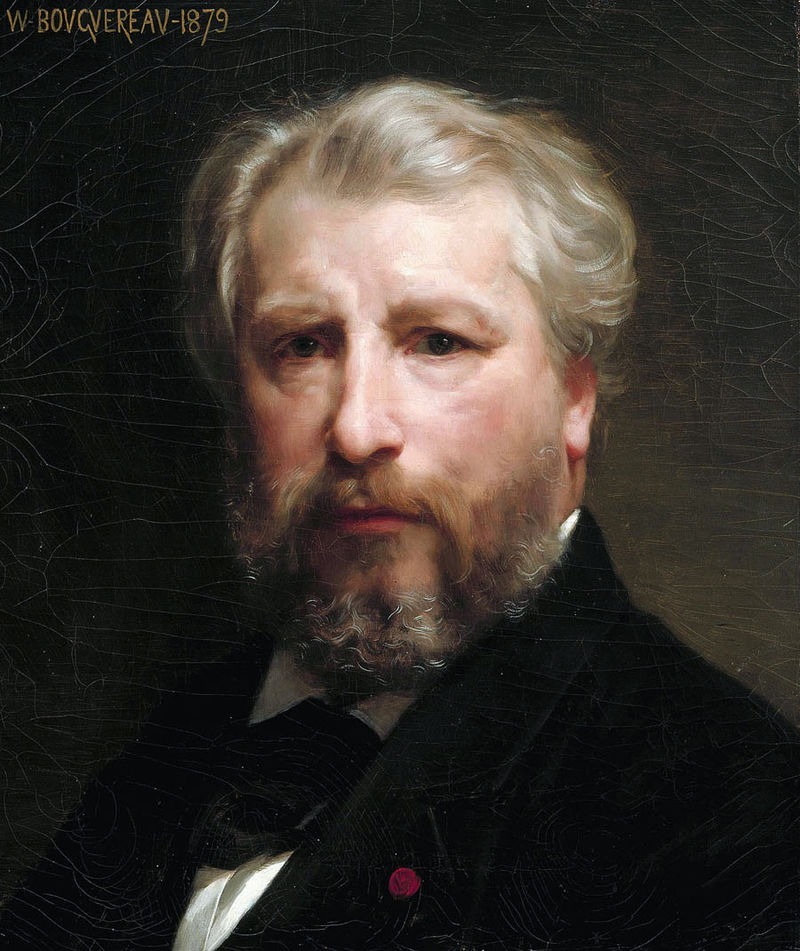

William Adolphe Bouguereau
FR
38
Artworks
1825 - 1905
Lifespan
Artist Biography
William-Adolphe Bouguereau, born in La Rochelle, France, on November 30, 1825, emerged from a family of wine and olive oil merchants. His early life was profoundly shaped by his uncle Eugène, a priest who instilled in him a love for nature, religion, and classical literature. Though initially set to join the family business, Bouguereau’s artistic inclinations were evident from a young age. He received his first formal art instruction from Louis Sage, a student of Ingres, at a Catholic college in Pons, and later attended the Municipal School of Drawing and Painting in Bordeaux. Working diligently as a shop assistant and hand-coloring lithographs, he saved enough to pursue his artistic ambitions in Paris, arriving in March 1846, driven by a desire to master his craft.
In Paris, Bouguereau immersed himself in academic training at the prestigious École des Beaux-Arts, studying under François-Édouard Picot. He diligently supplemented his formal lessons with anatomical dissections and studies of historical costumes. His dedication to the academic style, which prioritized historical and mythological subjects, culminated in winning the coveted Prix de Rome in 1850 for his painting "Shepherds Find Zenobia on the Banks of the Araxes." This prestigious award granted him a three-year residency at the Villa Medici in Rome. From 1851 to 1854, he studied Renaissance masterpieces and classical antiquities firsthand, an experience that profoundly influenced his choice of subject matter and artistic approach for the remainder of his prolific career, solidifying his commitment to neoclassical ideals.
Upon returning to France, Bouguereau became a dominant figure in the Paris Salon, exhibiting annually throughout his career. His realistic genre paintings and mythological themes, often featuring idealized interpretations of the female form, garnered significant popularity in France and the United States. He was celebrated for his technical mastery, particularly his ability to render skin, hands, and feet with remarkable precision. Major works like "Nymphs and Satyr" (1873), "The Holy Family" (1863), and "The Bather" (1864) exemplified his refined style. Bouguereau received numerous official honors, including the Legion of Honour, and secured lucrative commissions to decorate private residences, public buildings, and churches, such as the Grand Théâtre in Bordeaux and a chapel in La Rochelle, cementing his status as the quintessential salon painter of his generation.
Beyond his own artistic endeavors, Bouguereau was a highly influential teacher at the Académie Julian starting in 1875, where he notably advocated for the inclusion of female students. His personal life was marked by both joy and profound tragedy. He married his first wife, Nelly Monchablon, in 1866, and they had five children, though he sadly outlived four of them, including Nelly who died in 1877. Nineteen years later, in 1896, he married Elizabeth Jane Gardner, a former student and fellow artist. Despite personal hardships, Bouguereau remained incredibly prolific, often painting from dawn until dusk, completing an estimated 822 known paintings. He maintained homes and studios in Paris and his beloved La Rochelle, where he died from heart disease on August 19, 1905.
William-Adolphe Bouguereau's artistic style was characterized by a meticulous, highly polished realism, drawing heavily on classical subjects, both mythological and religious, with a distinct emphasis on the idealized female nude. His method involved detailed preparatory studies and oil sketches, resulting in a smooth, almost photographic finish. While he enjoyed immense popularity and commercial success during his lifetime, his traditional academic approach stood in stark contrast to the burgeoning Impressionist movement, whose members often derided his work. Consequently, by the early twentieth century, Bouguereau's art fell out of public favor as artistic tastes shifted towards modernism. However, a significant revival of interest in figure painting during the 1980s led to a rediscovery and critical reappraisal of his contributions, acknowledging his technical brilliance and lasting influence as a preeminent academic painter of the 19th century.